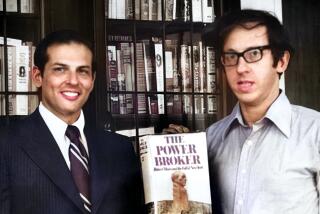Stars and Stripes Forever
It all started with a worn Civil War-era flag that had been passed down through the generations of Kit Hinrichs’ family. Made by his great-great-great-aunt Ida Pepperkorn in 1865, “it was this fabulous thing that my sister and I used to take to show-and-tell,” he recalls.
That 36-star flag became the cornerstone of what is now a 3,000-piece collection of American flags, as well as ephemera, folk art, jewelry, toys, posters, clothing, quilts and political memorabilia depicting the flag. Hinrichs, a 59-year-old graphic artist and partner in the San Francisco-based design firm Pentagram, has made about a quarter of this collection the subject of his new book, “Long May She Wave: A Graphic History of the American Flag” (designed by Hinrichs with Delphine Hirasuna, photos by Terry Heffernan; Ten Speed Press, 2001).
Lush photographs depict the flag in every way imaginable, from graphics on turn-of-the-century cigar boxes to a 1920s paper doll, a 1930s windup clown toy, 1960s Vietnam War protest posters, early American quilts, a World War II-era pillow cover, dominoes from 1880 and a Native American beaded coin purse. The flag has been used in countless political campaigns, to sell hundreds of products (that changed in 1934 with the adoption of a formal flag etiquette code).
Hinrichs’ collection soon became an unending source of history and knowledge about the flag: “I saw how it was created early on, in those proportions and in those colors,” he says. “The idea of the spirit of the American public actually creating this flag with built-in change represented a lot of what America’s about, always changing our environment, who we are.”
When he started amassing his collection, Hinrichs had no idea of the scope of the flag’s variations and depictions. “Once you begin to look,” he says, “you find it everywhere. It’s a ubiquitous symbol, in other countries as well as our own. As a protest piece, what better symbol? In many ways that shows the strength of the flag, that it’s such a powerful image, all over the world, good and bad.”
He finds items “everywhere” but locates his best pieces at antique shows, through magazines, and via the Internet. Now that he’s a well-known collector he’s often sent pieces, or pictures of them. Although his collecting “never stops,” Hinrichs admits his taste level has become elevated, causing him to search out the best of the best.
On his wish list are rare pre-Civil War items, folk art and cowboy boots decorated with the flag that so far he’s only glimpsed in museum collections.
One of Hinrichs’ favorite works wasn’t included in the book. It’s a photograph of his son, Christopher, whom he and his wife Linda adopted from Korea when the boy was 3. “When he became a citizen at about 7 or 8, we took a picture of him with the flag,” Hinrichs recalls. “He’s my joy.”
More to Read
Sign up for our Book Club newsletter
Get the latest news, events and more from the Los Angeles Times Book Club, and help us get L.A. reading and talking.
You may occasionally receive promotional content from the Los Angeles Times.






